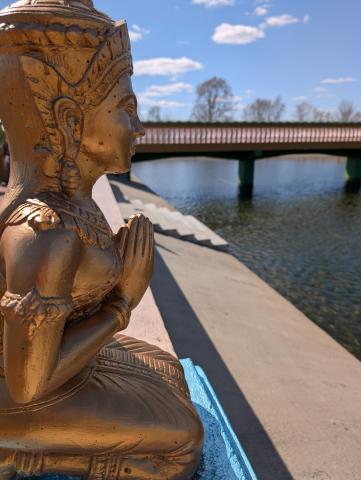This is part of my How I Teach Yoga series

Over the weekend, I subbed a “Mindful Yoga” class for Nancy Boler at Common Ground Meditation. Although I had been to Common Ground many times for talks, classes, and retreats, this was my first time teaching there. Nancy’s classes, like mine, weave together mindfulness and yoga.
In this article, I share how I teach mindful yoga, why it feels authentic, and how I bring yogic philosophy and Buddhist mindfulness into my yoga classes.
From Yoga to Meditation
For about five years, I practiced yoga regularly with my wife at our local yoga center, Spirit of the Lake. We often practiced 5-6 times a week. Initially, I focused mostly on the physical postures and not on yoga philosophy.
When my wife was diagnosed with cancer, I wanted to support her and I turned to meditation. I was drawn to meditation partly because articles about it kept popping up on tech sites like Hacker News. I looked for books about meditation at my local bookstore and the owner pointed me to Thich Nhat Hanh. When I searched for podcasts on “how to meditate,” I found one with that name from Amaravati Buddhist Monastery that introduced me to Buddhist meditation.
I was suspicious at first and then pleasantly surprised to learn that Buddhist practices invite direct experience rather than worship. There was nothing about the sin, guilt, or judgment I had learned about as kid in Sunday school. The mindfulness practices I learned helped me, so I kept practicing. (Thankfully, my wife remains healthy and cancer-free.)
My meditation journey deepened as I spent time in monasteries, joined weekly meditation groups, and sat retreats around the world (including at Amaravati in England). Locally, I volunteered with Bhante Seewalie and Bhante Kirti from the Minnesota Buddhist Vihara, sharing Buddhist meditation in prisons. The teachings resonated deeply with the incarcerated people. I studied the Pāli Canon with Bhikkhu Kamala at Triple Gem of the North. My kids still joke that I’m probably Buddhist.
Deepening Through Yoga Teacher Training
I wanted to dig deeper, and leaving my family to become a Buddhist monk wasn’t in the cards. I sought a path that allowed me to stay in the world. After a lot of reflection, I signed up for yoga teacher training (YTT) at Spirit of the Lake.
This training included my first encounter with the Yoga Sutras of Patanjali. Rather than chakras or mythology, I was surprised to find echoes of Buddhist teachings in the sutras. I noticed well-known lists that the Buddha used for teaching appeared exactly the same in the Yoga Sutras, such as the 4 sublime states, 3 unskillful roots, and 5 spiritual faculties.
After finishing my teacher training (RYT-200), I started teaching weekly yoga classes, and some of my first classes were called “Mindful Flow.” I gradually deepened my connection to Patanjali’s wisdom, especially after completing my advanced certification (RYT-500) with intensive 10-day retreats at Kripalu in Massachusetts. Immersed among dedicated practitioners and teachers, the sutras came alive as a living, ethical practice compatible with Buddhist thought.
How I Teach Mindful Yoga
For me, teaching a mindful yoga class is less about incorporating mindfulness in my yoga class and more about exploring the intersection between these two practices. When I subbed the mindful yoga class at Common Ground, I drew on my integrated experience. The breath awareness, attention to bodily sensation, and ethical underpinning of ahimsa (non-harming) are not separate techniques but facets of one aspiration: meeting each moment with clarity and care.
I organized the Common Ground class around the theme of aparigraha, the yogic principle of non-grasping. Inspired by Ajahn Amaro’s frequent teaching about moving from a self-centered perspective to a nature-centered perspective, I invited students to notice where they might be holding tension in body, breath, and mind. Each exhale provided a chance to soften.
I shared Ajahn Chah’s beautiful words:
“If you let go a little, you will have a little peace; if you let go a lot, you will have a lot of peace; if you let go completely, you will have complete peace.”
This theme helps ground mindfulness in the body and daily experience, making yoga an embodied practice of letting go rather than just a physical workout or a mental exercise. When we bring awareness to our breath, observe sensations without judgment, and reflect on principles like aparigraha (non-grasping) or ahimsa (non-harming), yoga becomes more than movement. It becomes a path of liberation in everyday life.
Mindful yoga weaves movement, breath, and ethical reflection into a seamless whole. In practice, the way I teach mindful yoga is closely related to how I teach Kripalu yoga or meditative yoga. I try not to get too caught up in all of the labels, but instead find what is beneficial and what leads to peacefulness and clarity.
Comments